Hill House aka Ettington Park, Stratford-Upon-Avon, UK
Ettington Park
The exterior scenes of The Haunting were shot in Ettington Park, Stratford-Upon-Avon, UK, Europe, whilst the interior scenes were shot in the MGM-British Studios, Borehamwood, UK, Europe.
Now
Foreword
It is very difficult to describe what it feels like for a fan to visit the house. When I turned 40 yo, for my birthday, I decided it was high time I paid a visit to Ettington Park aka Hill House for the very first time. I fondly remember the thrill when I peeked at the tower, above the trees, as I was approaching with my car. And then, after a curve, the house appeared. Of course, it looked so familiar and yet so strange (in colour!). I had booked one of the beautiful suites, right in front of the house, facing the park. What a memorable experience it was!
Ettington Park is a great location, great hotel, grand hotel to be accurate, with friendly staff and splendid rooms. I have found memories of my stay plus 1.500+ photos and videos to help me remember everything. If you are in Europe, I would highly recommend a visit.
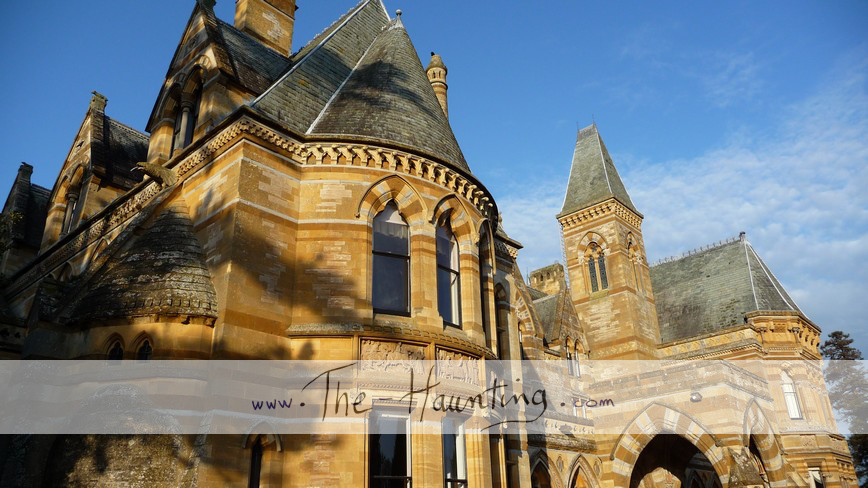
Ettington Park, Alderminster, Stratford-upon-Avon, Warwickshire, CV37 8BU, UK, Europe, also known as Hill House.
This picture was taken the day I arrived, at the end of the afternoon, before dusk, before the dark comes. I like it because most of the pictures you'll find on Internet will show you a front, right side or back side picture, but no one seems to care about the left side of the house. Now you can see it too.
Funnily, I rarely slept so deeply. I woke up so relaxed every day! I immediately felt "at home"! I had the room that you see in the middle of the picture: a suite located on the first floor, on the left side of the house. This suite is absolutely gorgeous.
You're here for Shakespeare? Well, No!
It is almost a running joke. A lot of people — mostly hotel guests — will ask you: so, you're here for the Shakespeare festival too? [Replace festival by any Shakespeare-related event or place]. But, no, I'm not here for Shakespeare, I'm here for the House. I know Shakespeare was born right here, nearby, but, no, I'm not interested and not ashamed to say.
Practically speaking, I would strongly advise you to book a long time in advance, plus to check if your travel dates are not coinciding or colliding with a Shakespeare-related event, festival, retrospective, special exhibition, etc.
Stratford-Upon-Avon, UK, Europe
Isn't it ironic to think that Shakespeare was born in Stratford-Upon-Avon, UK, Europe, where you can also find the superb Ettington Park hotel — where the exteriors scenes of 'The Haunting' were shot?
If you stay at Ettington Park for a few days, a lot of the visitors of the hotel will be there precisely because of Shakespeare, and not for 'The Haunting'. Apparently, Shakespeare attracts more visitors. Weird, isn't?
On the map
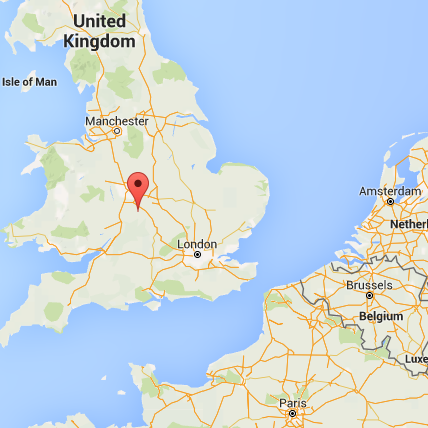
Ettington Park
Alderminster
Stratford-upon-Avon
Warwickshire
CV37 8BU
UK
Europe
Exteriors
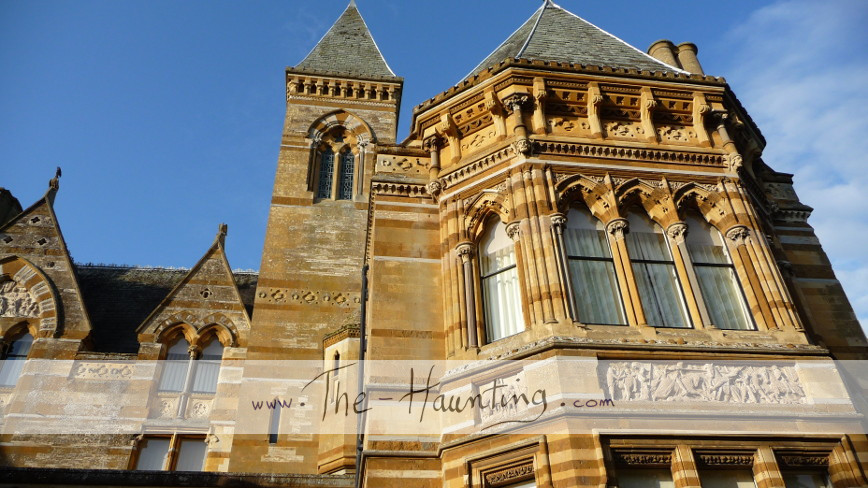
The grand, magnificient facade of Ettington Park.
I took lots of pictures of Ettington Park during my stay, at anytime of the day, with variable weather conditions. I've experienced it all: sunny days, rainy days, at night, at dusk, at dawn, at noon, but looking back at them now, I believe that the warm light just before dusk gives the stones of the house very rich and vibrant colours. These warm pictures are my favourites. In the last pictures of this section, I also wanted to show you the pillar Eleanor leans on.
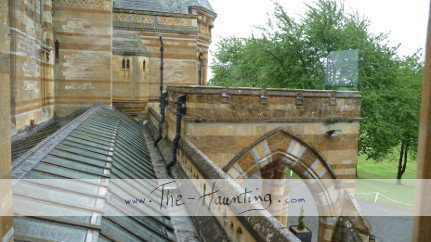
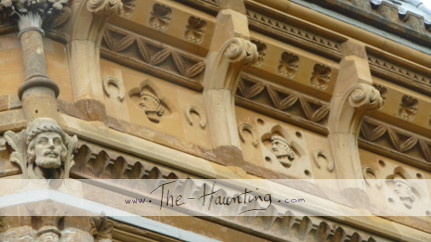
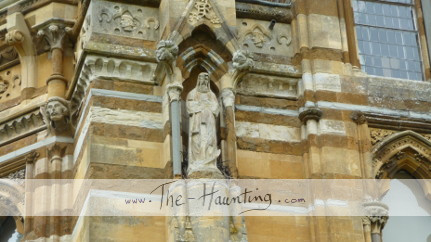
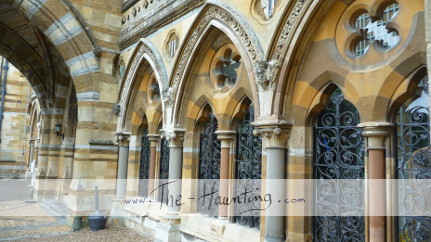
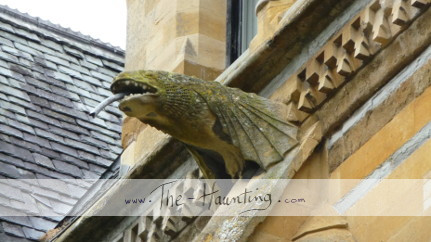
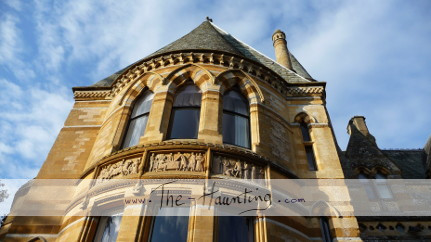
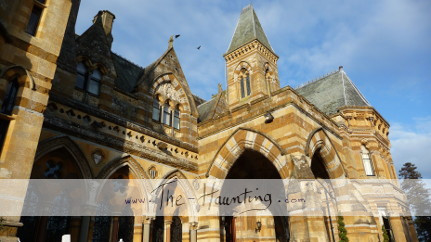
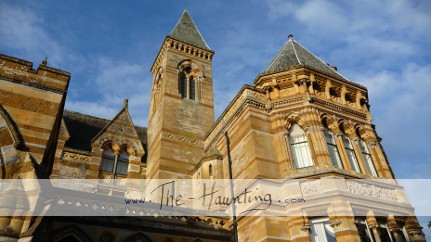
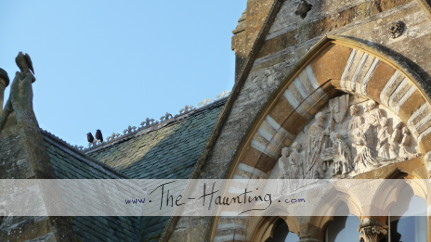
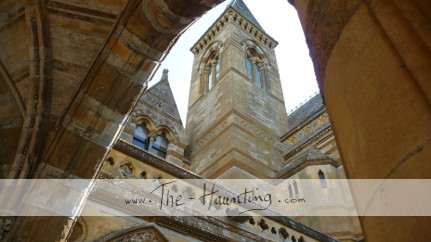
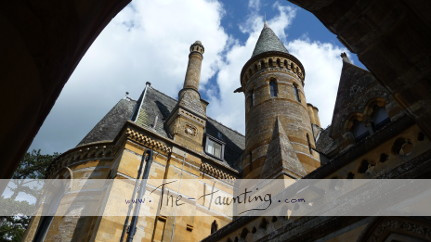
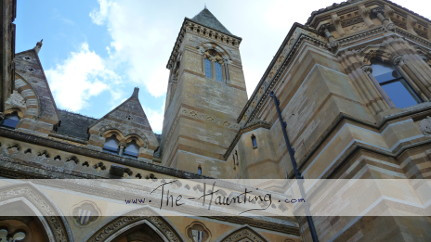
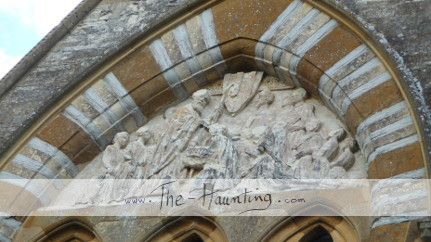
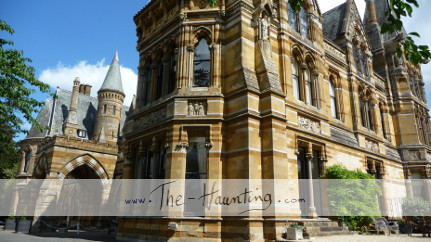
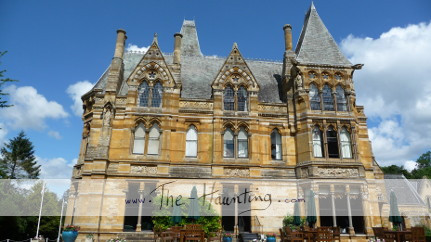
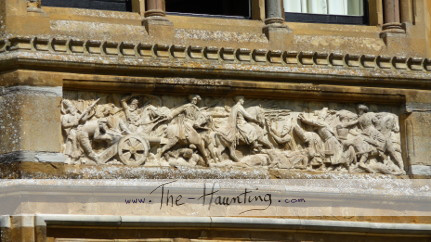
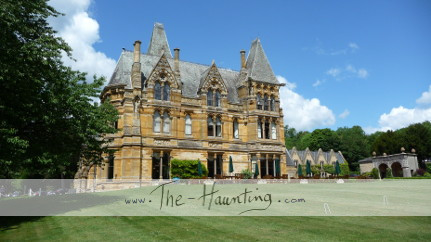
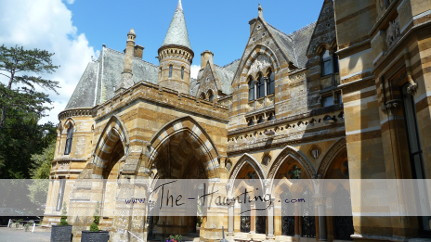
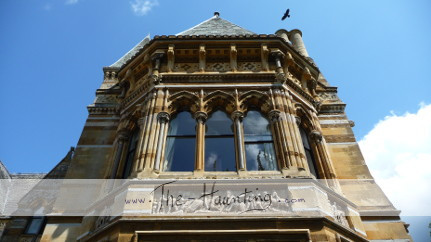
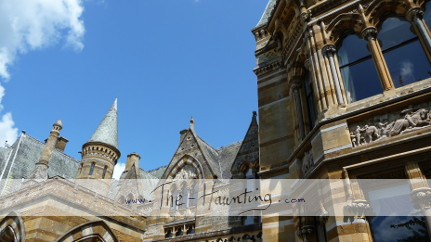
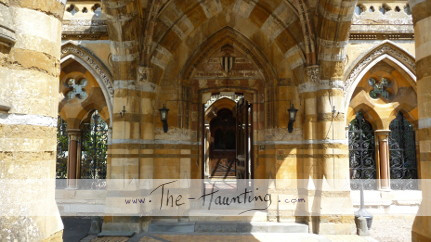
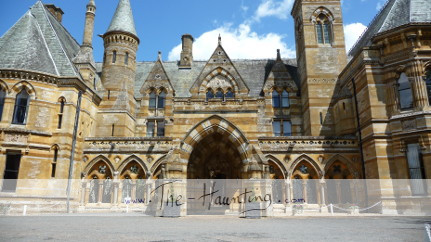
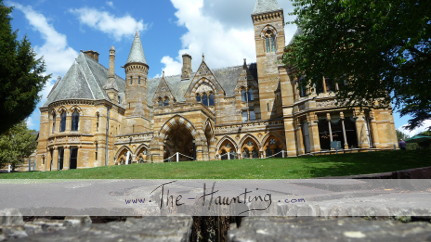
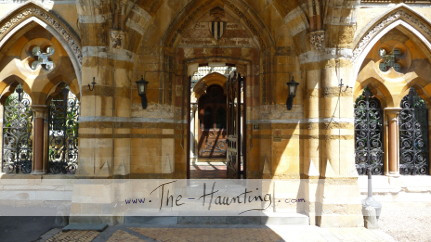
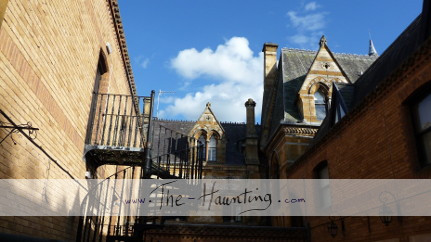
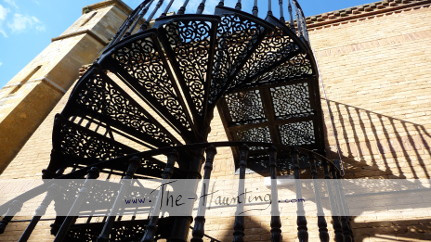
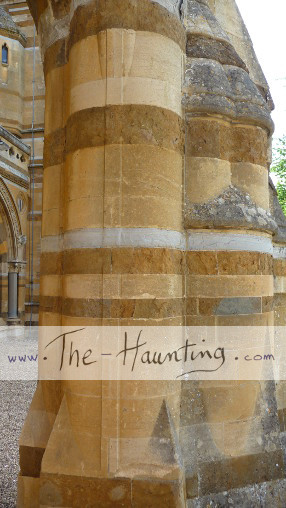
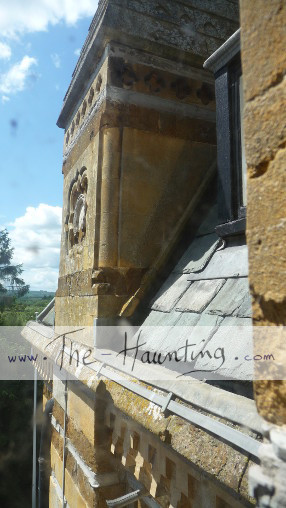
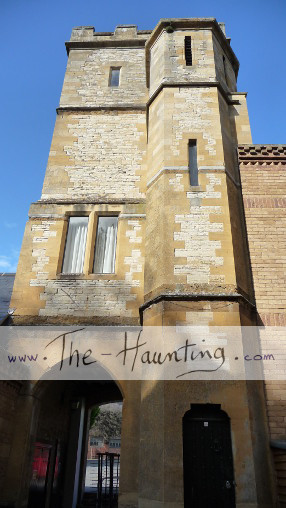
In the garden
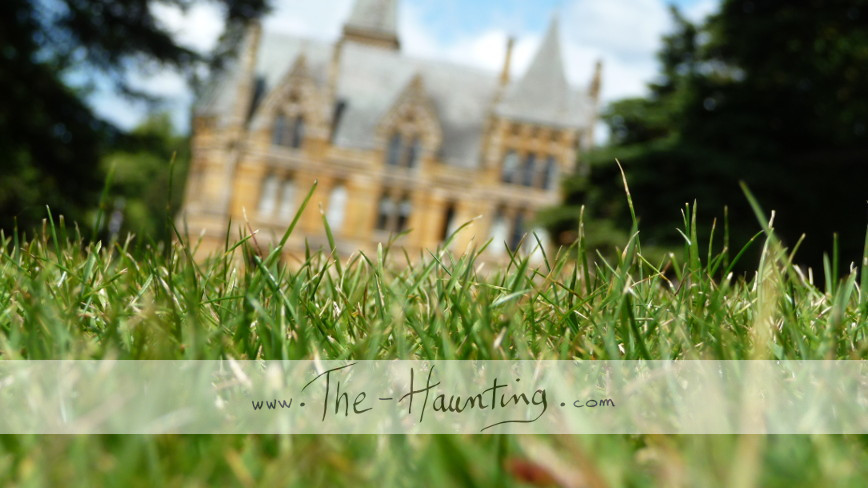
A green decor for the jewel.
The house is not the only building on the grounds at Ettington Park, but, obviously, as a fan of The Haunting, the main house got all my interest. The property is perfectly delimited with water (River Stour) or with a stone wall. The grass is impeccably trimmed and groomed. There are rare flowers here and there — if you were expecting an English garden, try somewhere else — but this is perfect as it is. This garden actually makes the house really stand out: the focal point of interest. I was intrigued to see where the path from the main entrance lead to. If you're outside, facing the house, the actual road comes from the left side, with some parking space under the trees. In the movie, Eleanor seems to come from the right side (impossible, it is a garden) but actually comes from a straight path right in front of the house. This old road in front of the house still exists, but cannot be used anymore. It leads to a rusted metal bridge (over troubled water), which began to fall apart, literally in pieces. The access to the bridge is blocked by a wooden fence.
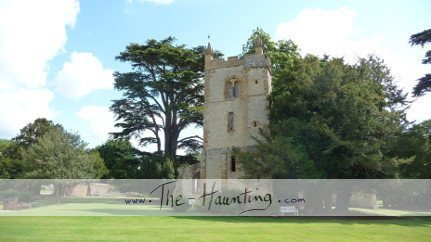
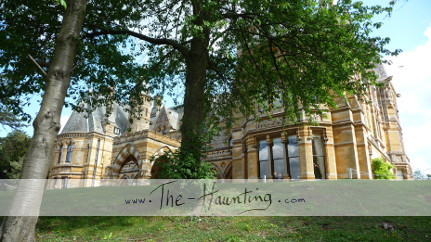
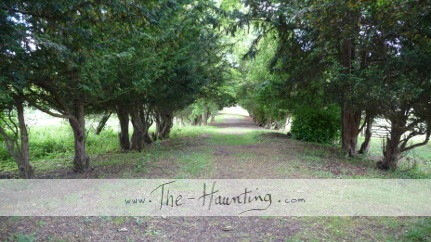
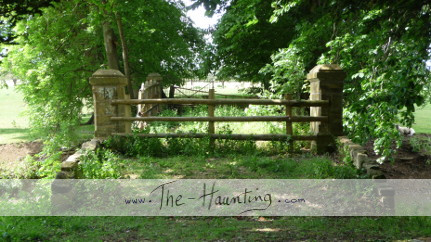
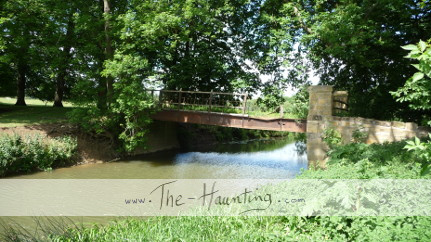
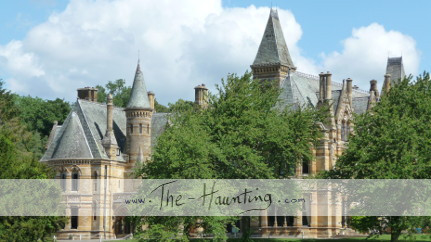
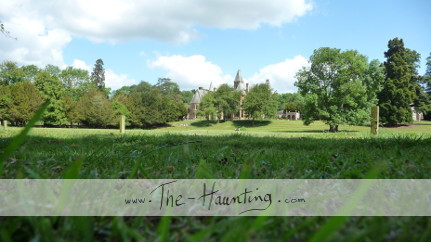
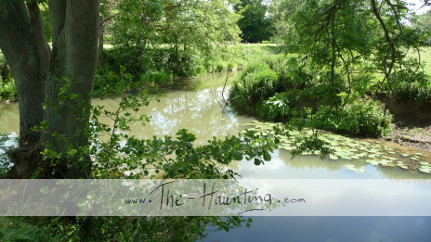
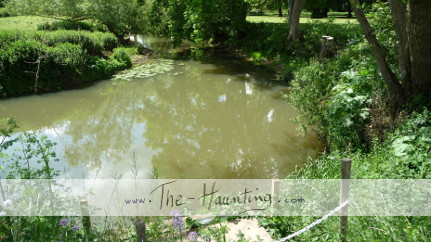
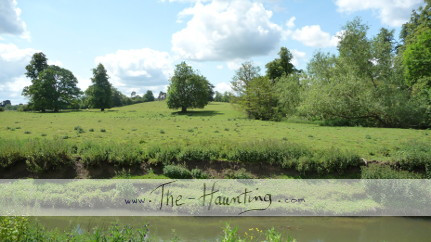
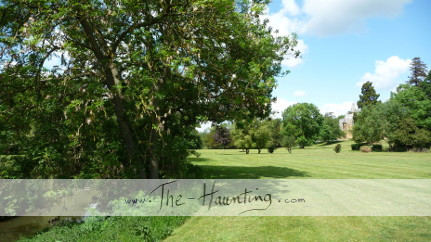
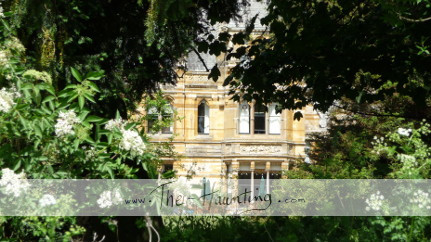
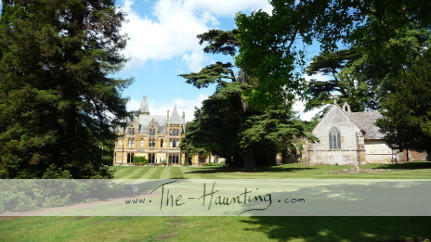
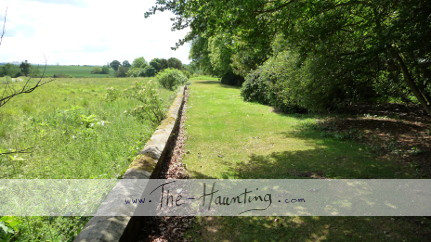
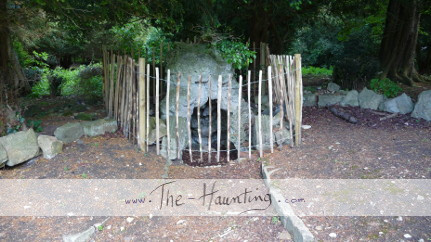
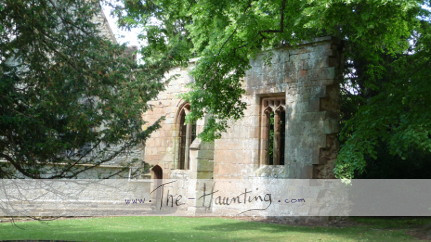
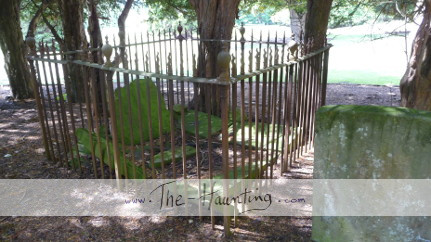
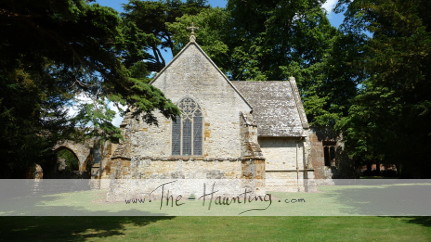
In the night, in the dark
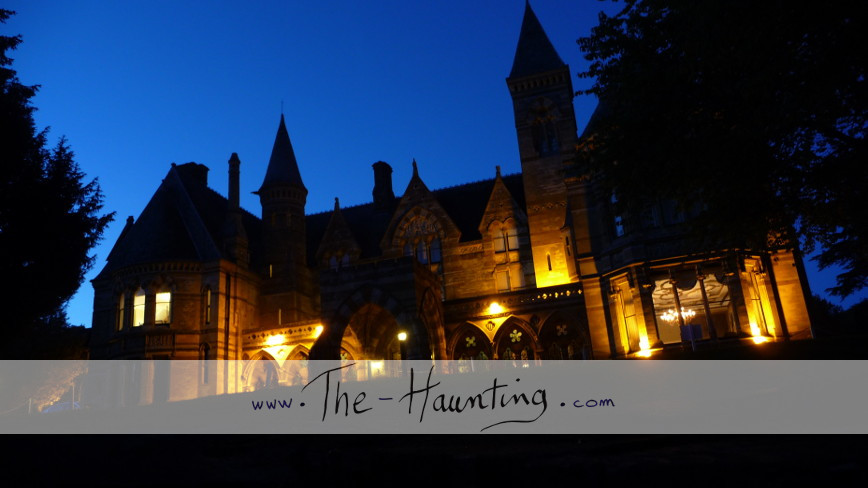
Mrs. Dudley warned you, though.
At night, what a thrill! The threatening shape of Ettington Park, cut in the dark blue sky is simply splendid! By the way, I wonder who wanted to have a silhouette picture taken from the suite I was occupying... The hotel is equipped with various lights placed at strategic places to really enhance this fabulous heritage from the past.
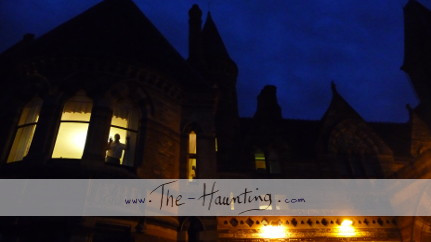
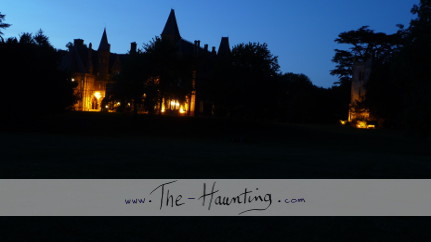
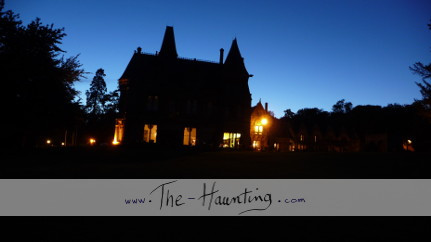
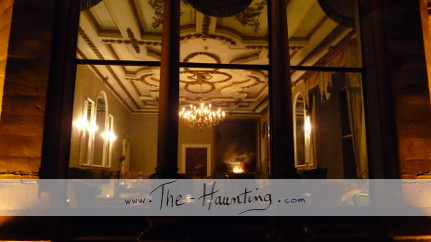
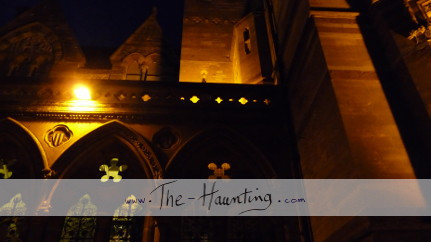
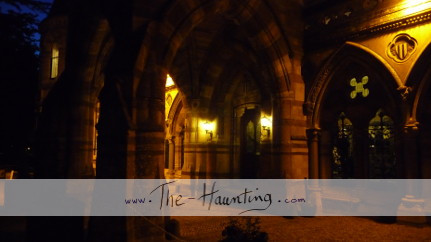
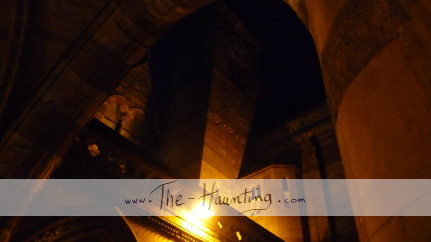
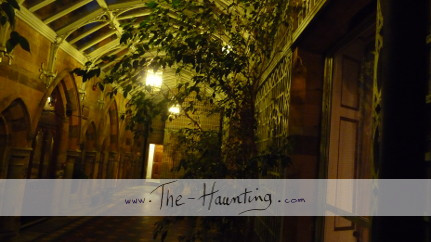
Inside
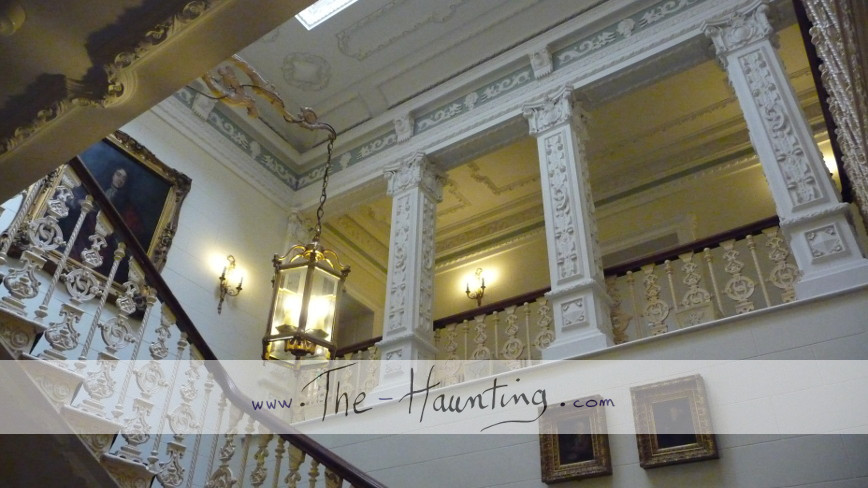
Gothic and flamboyant.
The interior rooms of Ettington Park are less relevant for the fans of The Haunting, because they were not used in the movie. Still, I wanted to give you a glimpse of the style. Did you notice the 'Loyal je suis' (french, translated as I am loyal) message on the tiled floors?
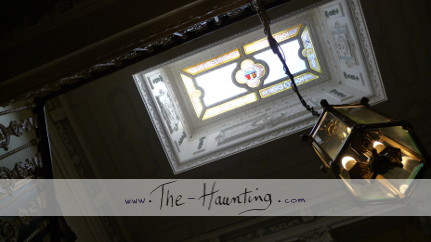
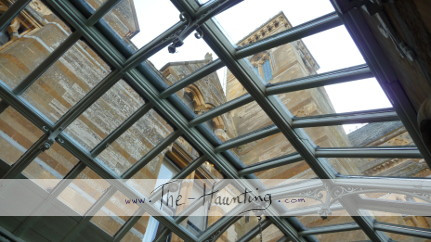
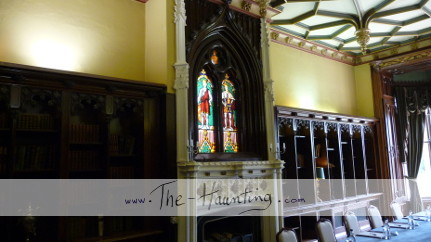
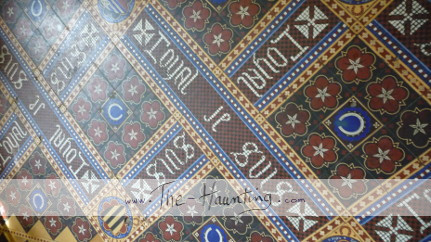
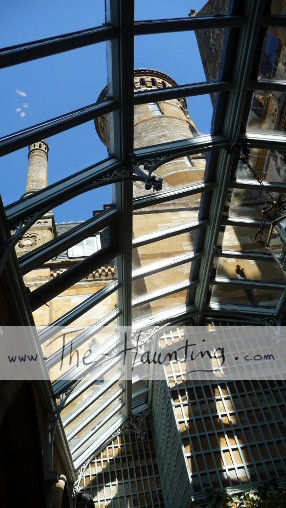
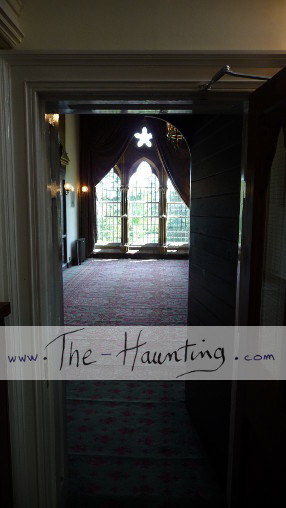
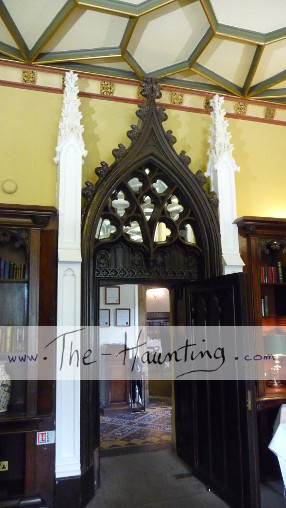
The towers
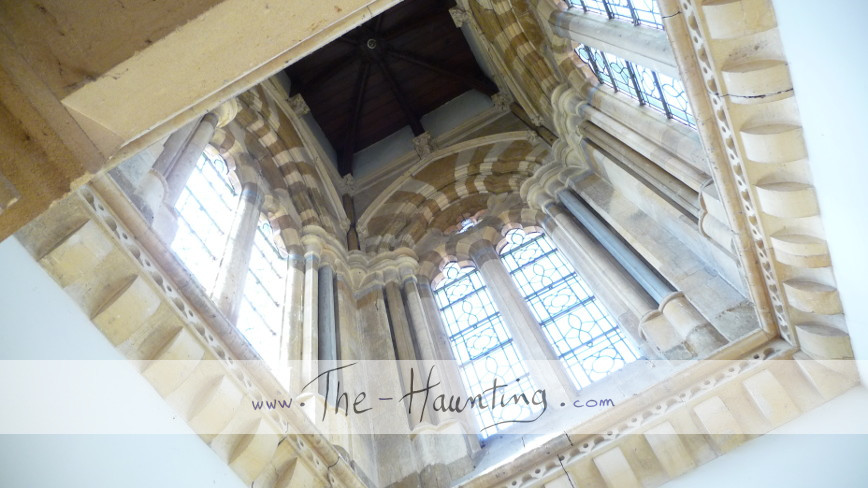
What is really inside the main tower.
The towers of Ettington Park! I have to explain again that the staff of the hotel was really friendly and let me have a look inside. Both towers are actually emergency exits, and are not for visitors to explore. The round tower was close to my suite. The stairs are in stone. The square tower — the one mentioned by Eleanor in The Haunting — has wooden stairs with sculpted figures. Notice the green & white décor on the stained glass windows, that can hardly be perceived in the bright light.
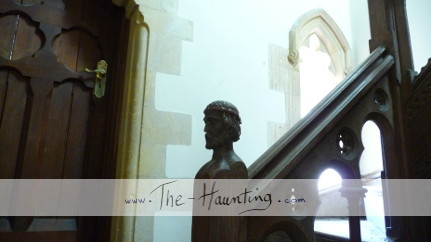
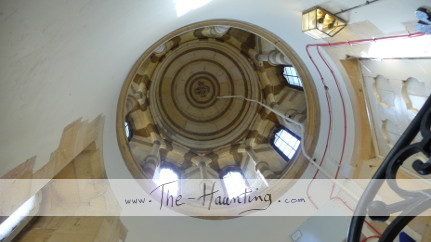
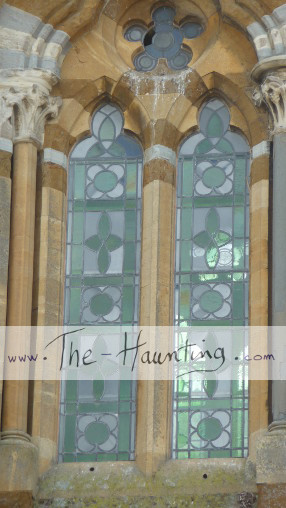
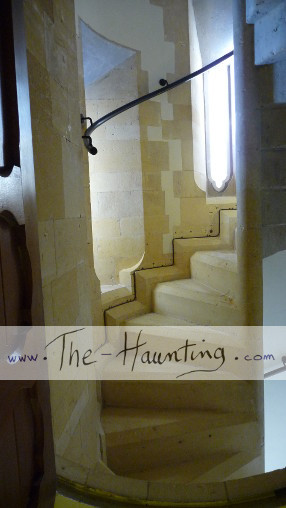
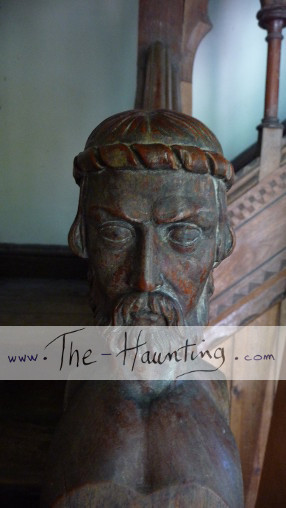
Sum scutum de auro et nigro senis. Ductibus palatum.

The coat of arms and the Latin inscription above the main entrance door.
My friends, I need all the help I can get to decipher this mysterious inscription. This black and white coat of arms is accompanied by a Latin phrase:
I've searched but haven't managed to find a definitive translation. If you have the answer to this riddle, please don't hesitate to contact me. Here is the result of my search:
My friend David: I am the gold and black shield of an old man wandering for the lords (who is wandering: the shield, not the man).
ChapGPT: I am a gold and black shield, guided by the wisdom of an old man.
Google: I am the gold and black shield of the old man.
Translate.com: I am the shield of the gold and black of the old man.
Lingvanex: I'm a shield of gold and black old man's swings palate.
Copilot: I am a shield of gold and black, a palace for the elders.
Happy birthday!
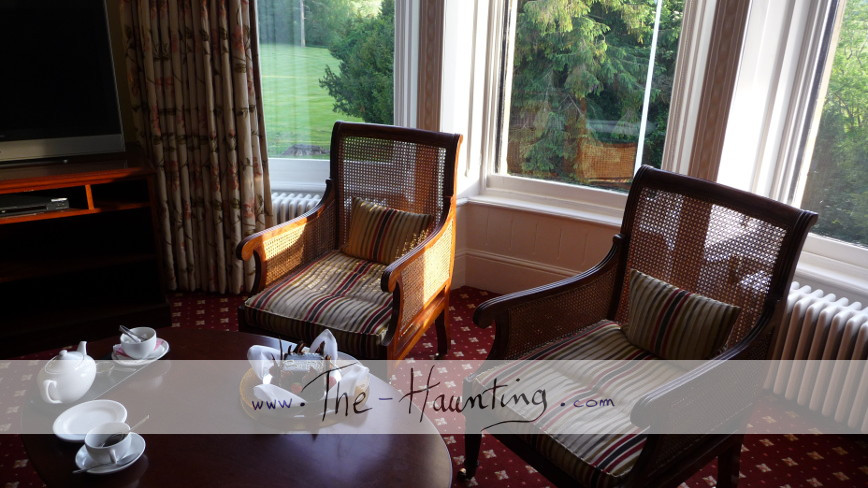
Birthday party at Ettington Park.
A birthday celebration at Ettington Park, a souvenir that will never go away! The chef was really accommodating and nicely executed my suggestion to have a strawberry and chocolate cake with a "happy birthday" message. I'm so grateful for this memorable moment. You can also see the Shirley suite #48 and imagine what it feels like for a fan of The Haunting to be there!
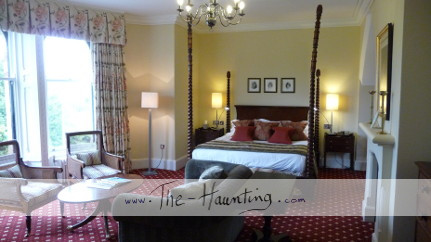
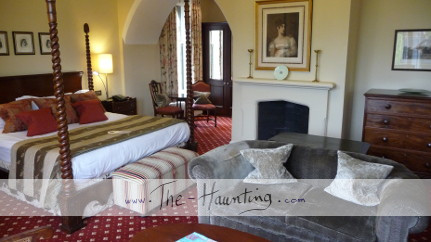
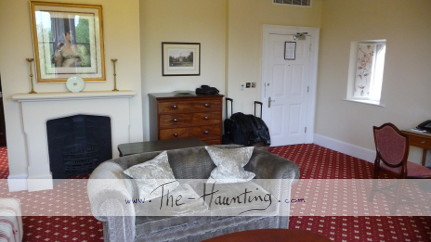
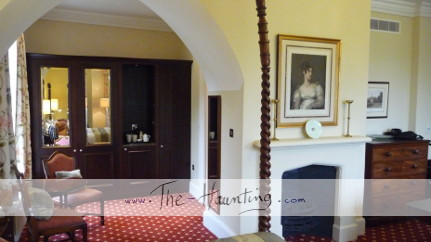
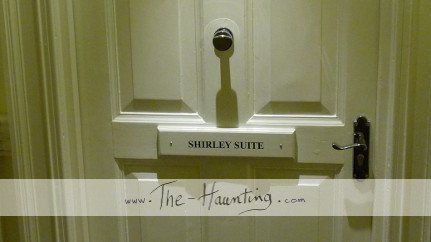
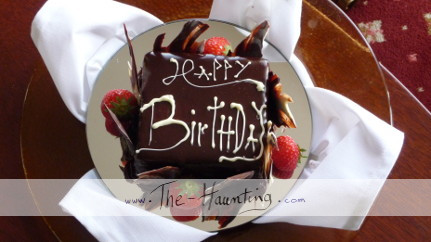
Something peculiar
With the help of PhotoShop, I wanted to create unusual pictures of the house; un-natural pictures, if you prefer.
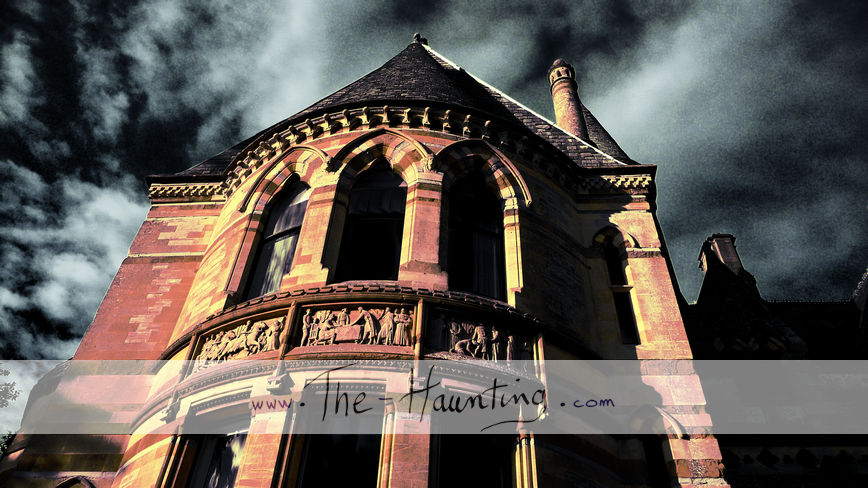
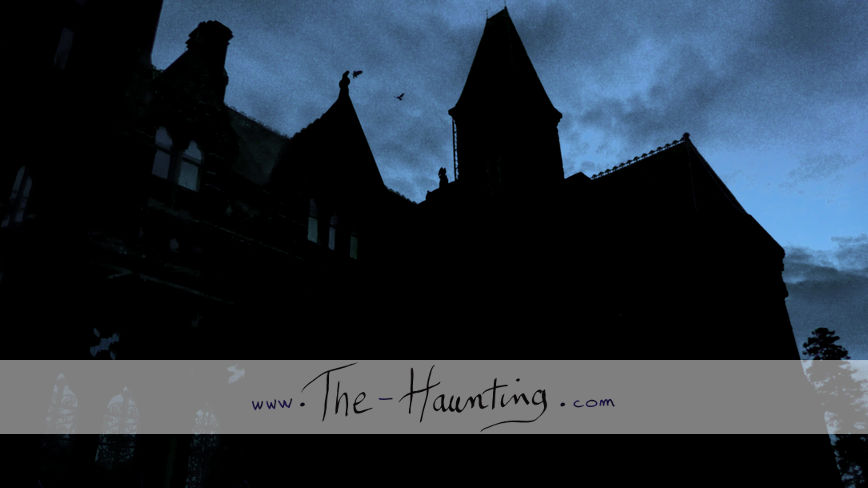
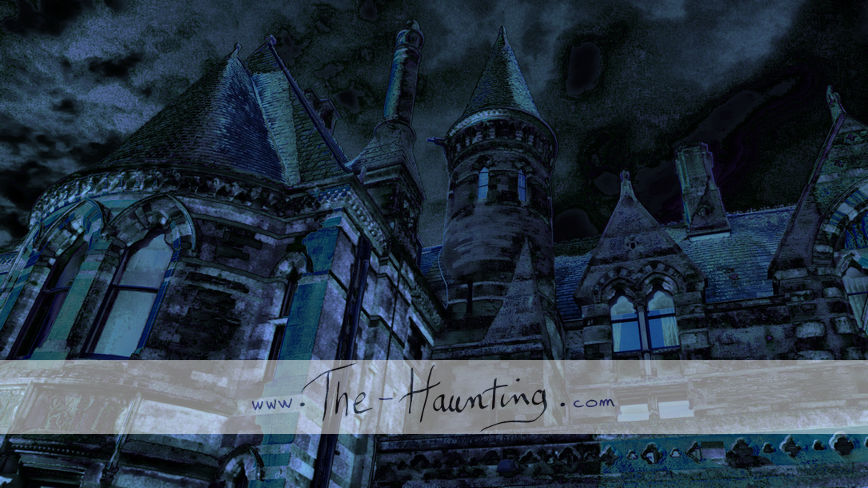
I hope you like the result.
Fan-made tours of Ettington Park
Source: YouTube, Channel: thomasfbryant, Video: Return to the Haunting of Hill House
Source: YouTube, Channel: RSP Drone Photography, Video: The Ettington Park Hotel In Color
Documentaries
Source: YouTube, Channel: GhostWatching, Video: [BBC] Ghosts of Ettington Park Hotel... Carol Vorderman
The 1869 Building News and Engineering Journal
This is an exceptional document. The "Building News and Engineering Journal – volume 16 – January-June 1869" comments the remarkable changes ordered by E. P. Shirley, Esq. for its cosy home, Ettington Park ("Eatington Park" back then). The accompanying review comments the work of John Prichard (text) or John Porchard (drawing), the architect, and provides a multitude of details regarding this makeover and the material that were used.
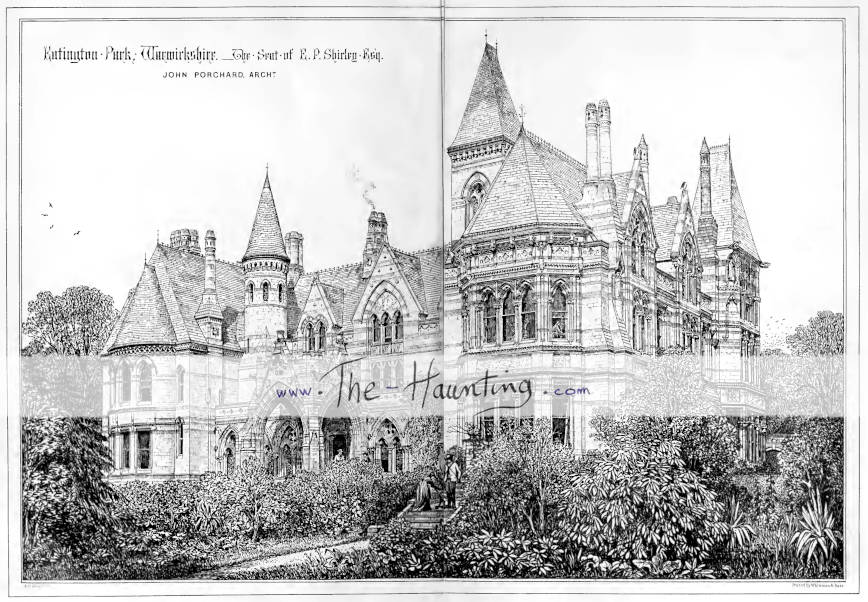
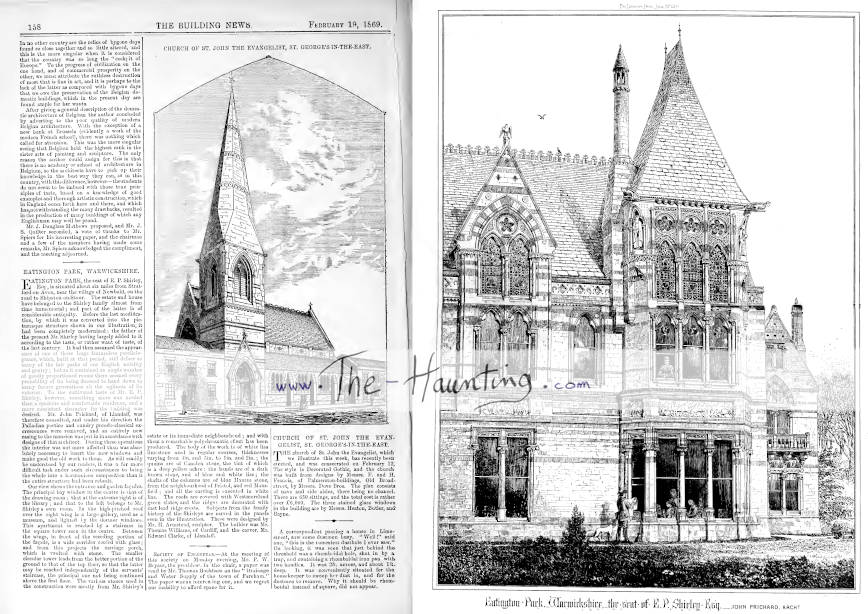
Eatington Park, Warwickshire
Eatington Park, the seat of E. P. Shirley, Esq., is situated about six miles from Stratford-on-Avon, near the village of Newbold, on the road to Shipston-on-Stour. The estate and house have belonged to the Shirley family almost from time immemorial ; and part of the latter is of considerable antiquity. Before the last modification, by which it was converted into the picturesque structure shown in our illustration, it had been completely modernized ; the father of the present Mr. Shirley having largely added to it according to the taste, or rather want of taste, of the last century. It had then assumed the appearance of one of those huge featureless parallelograms, which, built at that period, still deface so many of the fair parks of our English nobility and gentry ; but as it contained an ample number of goodly proportioned rooms there seemed every probability of its being doomed to hand down to many future generations all the ugliness of its exterior. To the cultivated taste of Mr. E. P. Shirley, however, something more was needed than a spacious and comfortable residence, and a more consistent character for the building was desired. Mr. John Prichard, of Llandaff, was therefore consulted, and under his direction the Palladian portico and sundry pseudo-classical excrescences were removed, and an entirely new casing to the mansion was put in in accordance with designs of that architect. During these operations the interior was not more affected than was absolutely necessary to insert the new windows and make good the old work to them. As will readily be understood by our readers, it was a far more difficult task under such circumstances to bring the whole into a harmonious composition than if the entire structure had been rebuilt.
Our views show the entrance and the garden façades. The principal bay window in the centre is that of the drawing-room ; that at the extreme right is of the library ; and that to the left belongs to Mr. Shirley's own room. In the high-pitched roof over the right wing is a large gallery, used as a museum, and lighted by the dormer windows. This apartment is reached by a staircase in the square tower seen in the centre. Between the wings, in front of the receding portion of the façade, is a wide corridor roofed with glass ; and from this projects the carriage porch, which is vaulted with stone. The smaller circular tower leads to the better portion of the ground to that of the top floor, so that the latter may be reached independently of the servants' staircase, the principal one not being continued above the first floor. The various stones used in the construction were mostly from Mr. Shirley's estate or its immediate neighbourhood ; and with them a remarkable polychromatic effect has been produced. The body of the work is of white lias limestone used in regular courses, thicknesses varying from 4in. and 5in. to 1in. and 2in. ; the quoins are of Camden stone, the tint of which is a deep yellow ochre ; the bands are of a dark brown stone, and of blue and white lias ; the shafts of the columns are of blue Hanam stone, from the neighbourhood of Bristol, and red Mansfield ; and all the carving is executed in white lias. The roofs are covered with Westmoreland green slates, and the ridges are decorated with cast lead ridge crests. Subjects from the family history of the Shirleys are carved in the panels seen in the illustration. These were designed by Mr. H. Armstead, sculptor. The builder was Mr. Thomas Williams, of Cardiff, and the carver, Mr. Edward Clarke, of Llandaff.
The postcards from the old days...
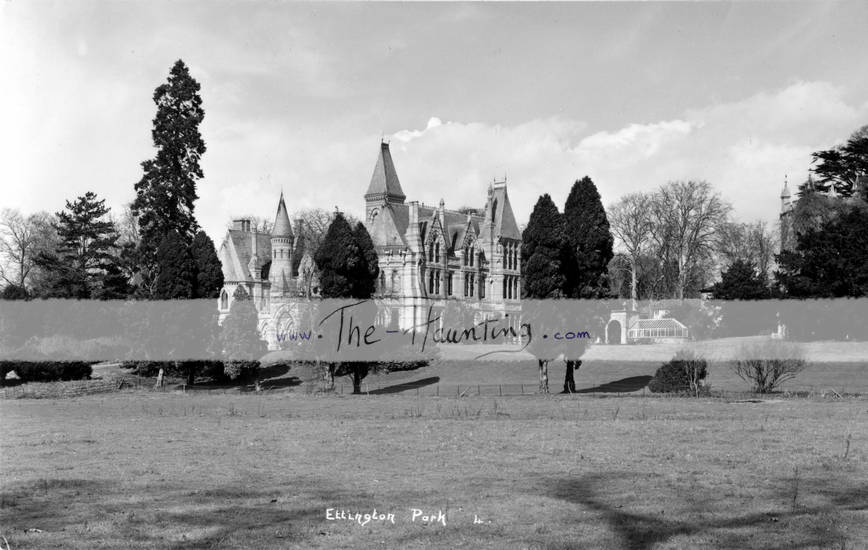
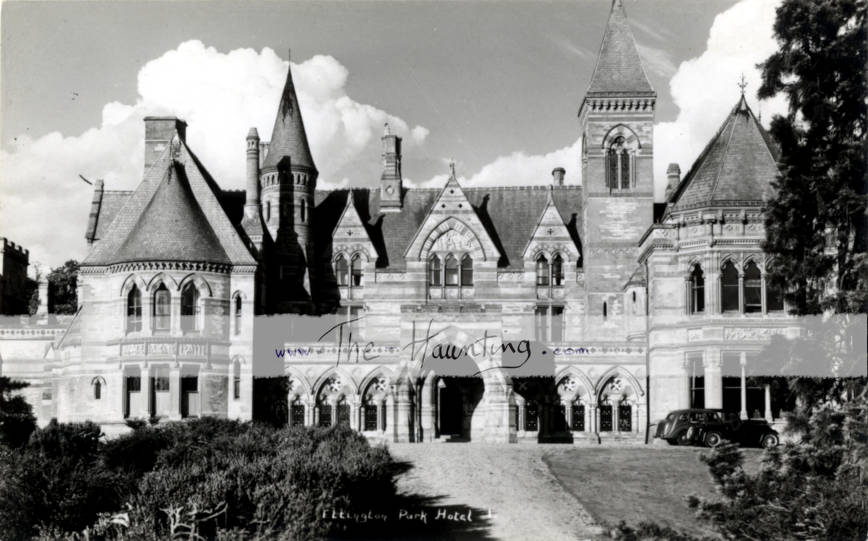
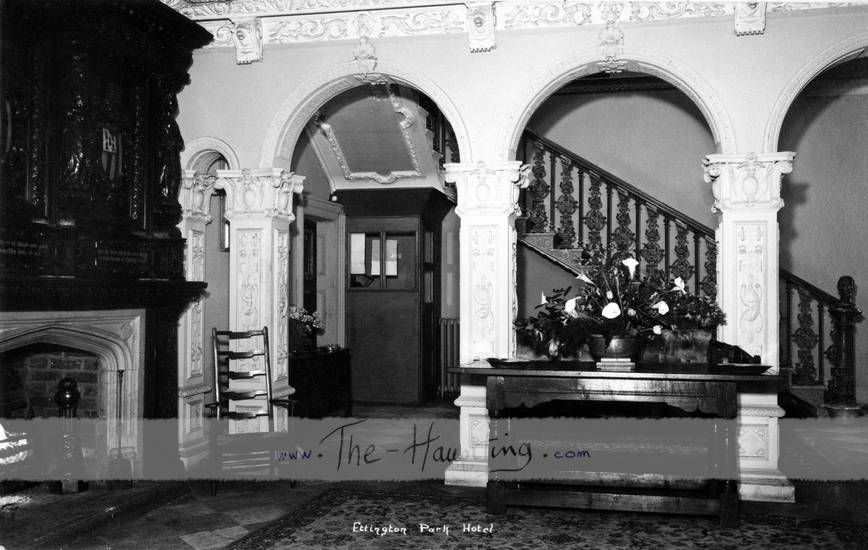
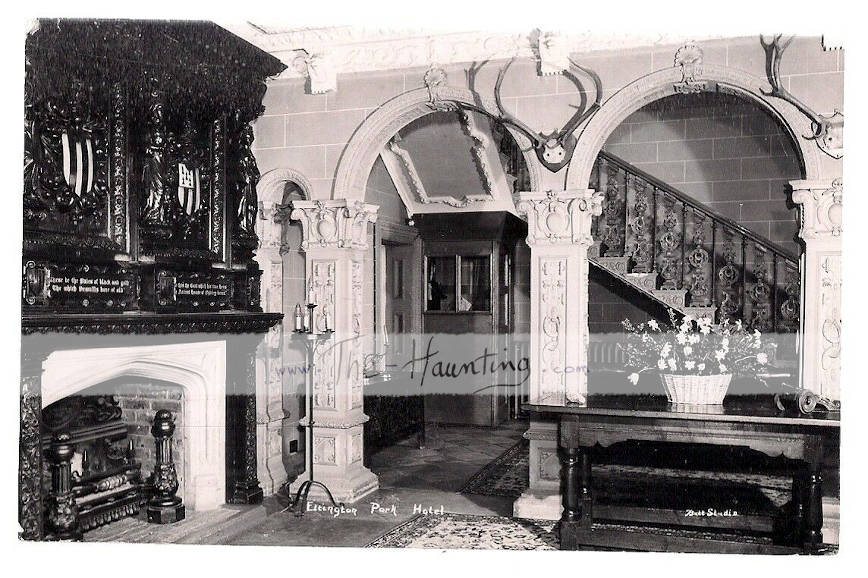
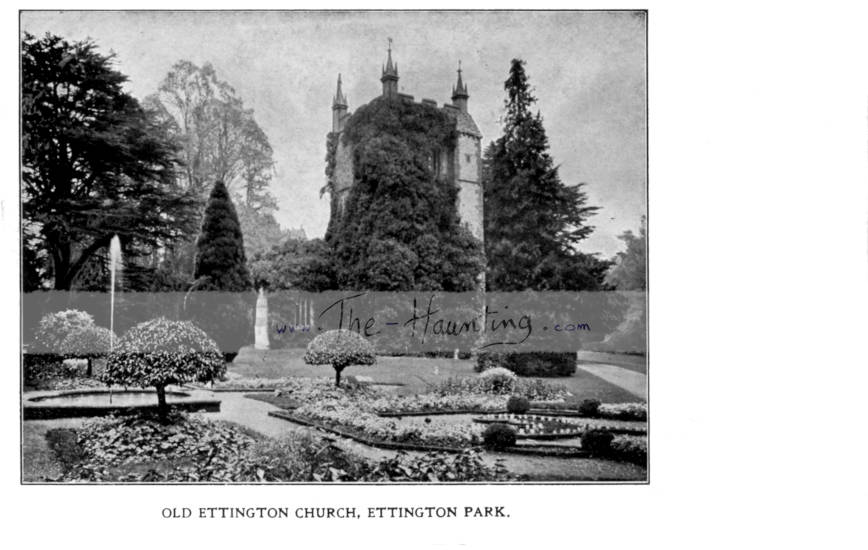
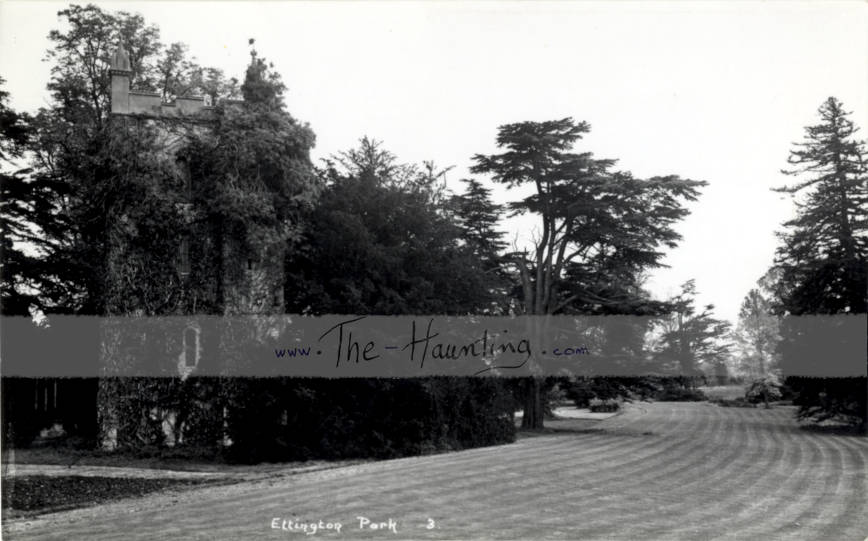
A large number of very old photographs of Ettington Park can be found. The place was a local curiosity, long before the filming of the movie took place. Consequently, it is not uncommon to find black and white pictures of the house, taken a long time ago.
The postcards from today...
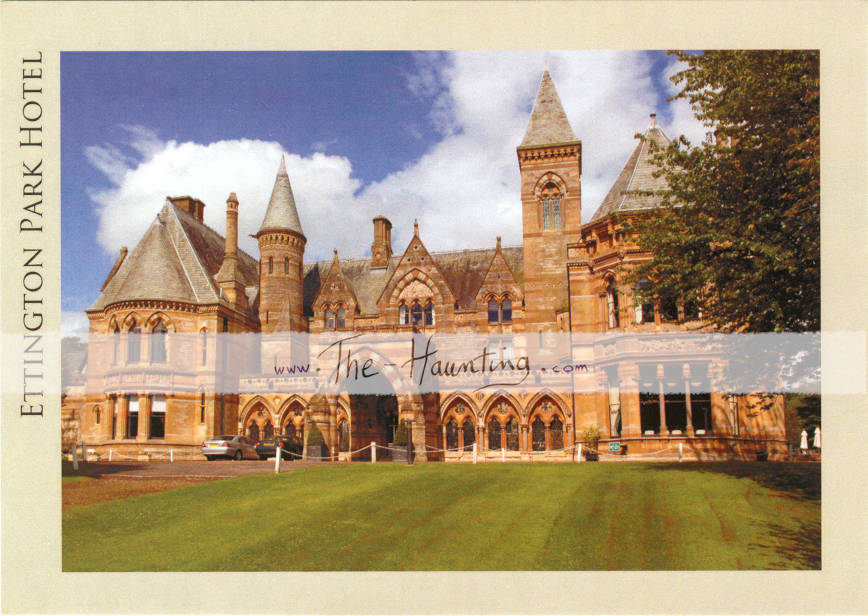
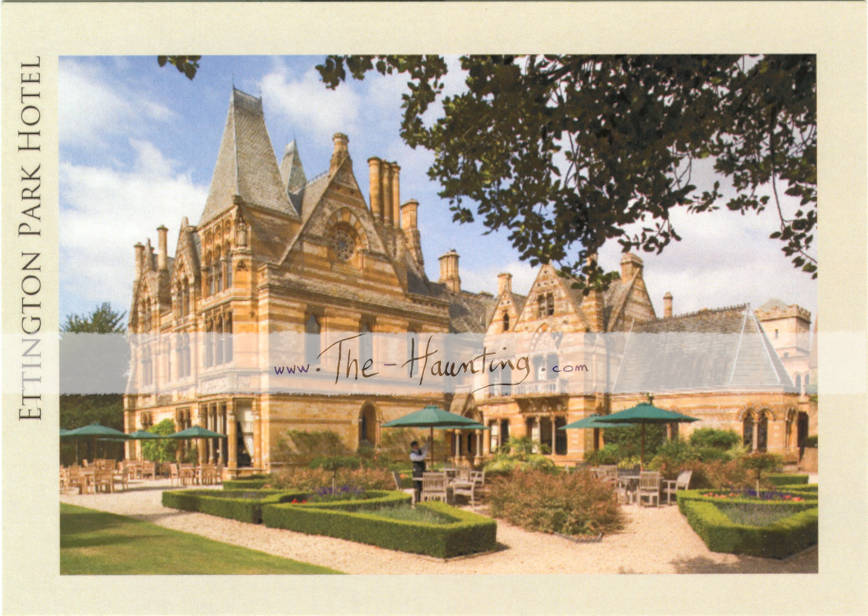
The 1947 (Content) Auction sale
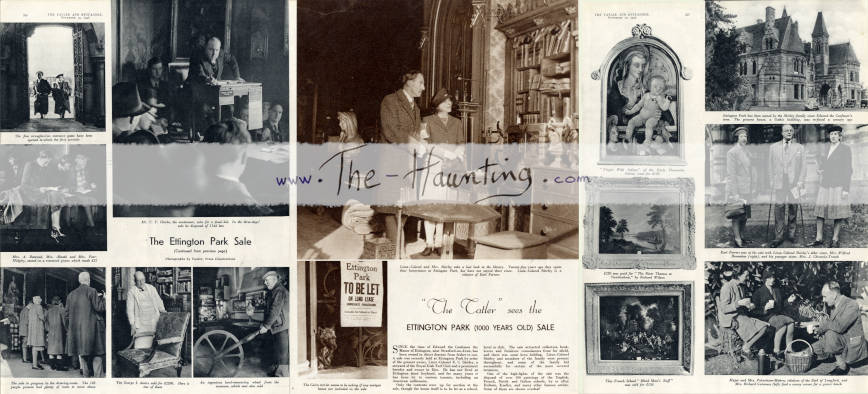
As explained in this illustrated article from The Tatler, dated Nov. 23, 1947, a three-day auction sale took place at Ettington Park, to sell 1144 lots, including paintings, furniture and books. The owners of the estate, Lieut.-Colonel and Mrs. Shirley were attending. The 120 people present could hesitate between a £22 rosewood piano, and a £2.200 George I. chair...
Ettington Park was also to be let on long lease.
Here is a transcript of the text from the article:
Since the time of Edward the Confessor the Manor of Ettington, near Stratford-on-Avon, has been owned in direct descent from father to son. A sale was recently held at Ettington Park by order of the present owner, Lieut.-Colonel E. C. Shirley, a steward of the Royal Irish Turf Club and a prominent breeder and owner in Eire. He has not lived at Ettington since boyhood, and for many years it has been let to various tenants, including an American millionaire. Only the contents were up for auction at the sale, though the house itself is to be let as a school, hotel or club. The sale attracted collectors, book-lovers and furniture connoisseurs from far afield, and there was some keen bidding.
Lieut.-Colonel Shirley and members of the family were present throughout, and some of the family bid successfully for certain of the more coveted treasures.
One of the high-lights of the sale was the disposal of over 100 paintings of the English, French, Dutch and Italian schools, by or after Holbein, Kneller, and many other famous artists. Some of them are shown overleaf.
The 1969 Hotel Brochure
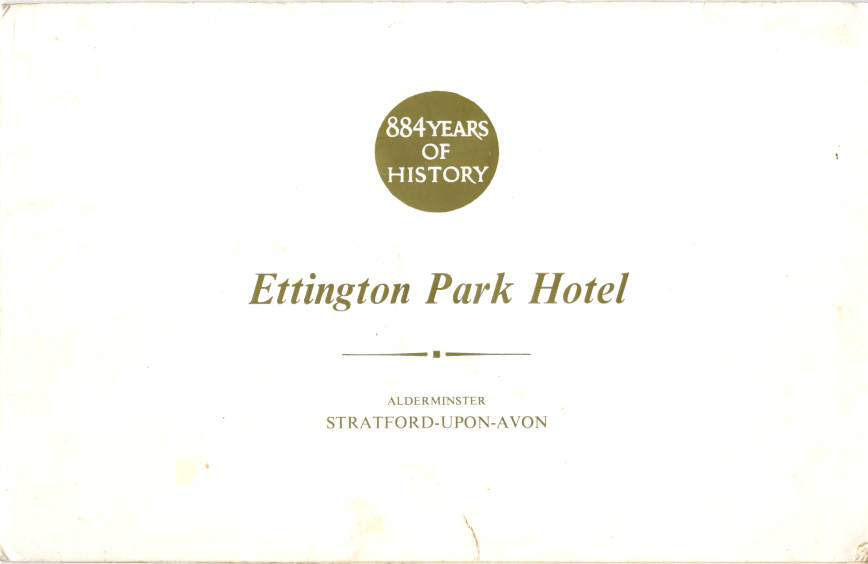
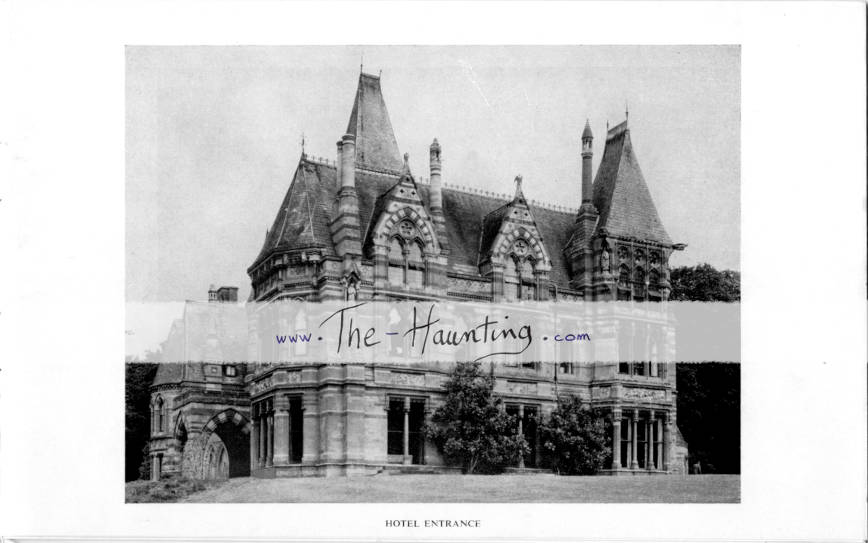
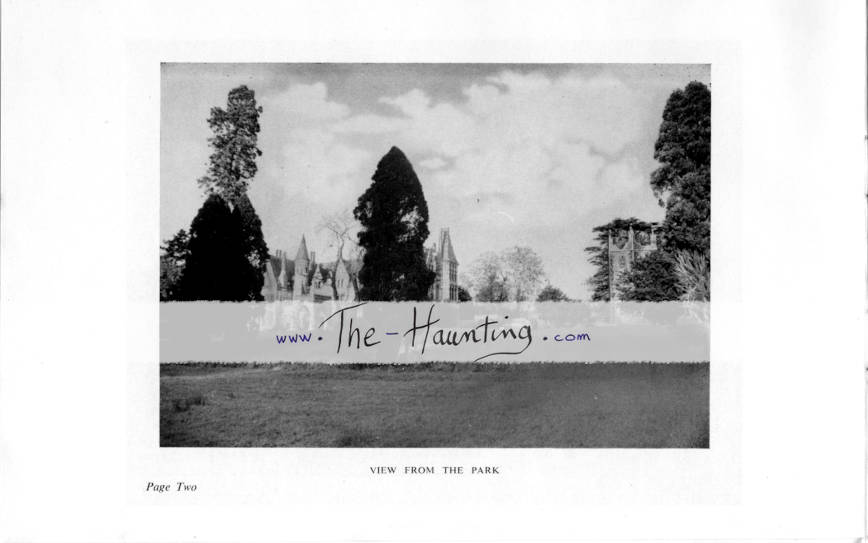
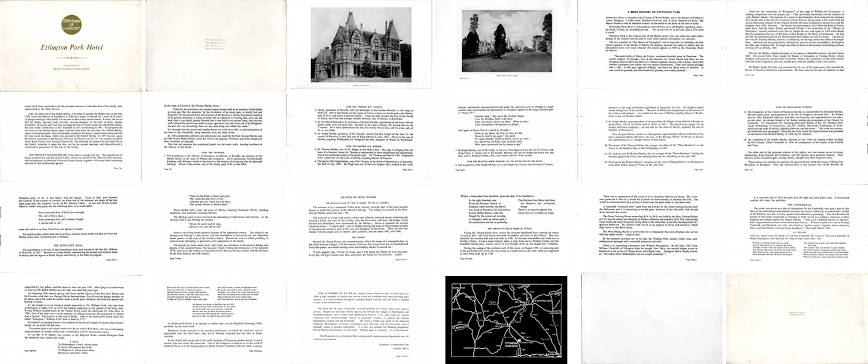
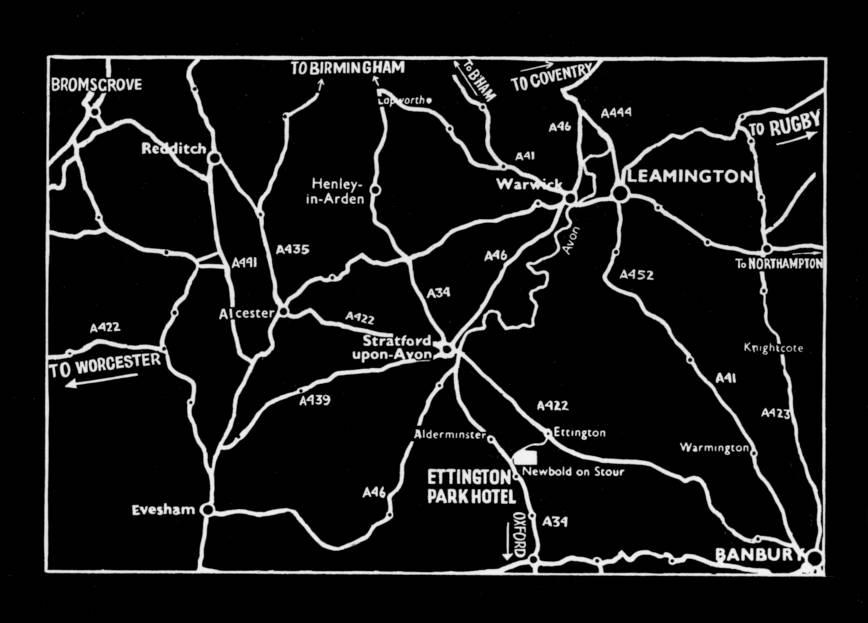
A brief history of Ettington Park
Ettington Park is situated in the County of Warwickshire and is the Manor of Nether or Lower Ettington 5 miles (8 kilometers) from Stratford-on-Avon and 4 miles (6.5 km) from Shipston-on-Stour. The Manor House is built in beautiful country on the banks of the Stour at the foot of a hill.
Domesday Book gives it as Eatendone, derived from ea in old English, signifying water; the Dune or Dun, an ascending ground. "For at the foot of an hill and near a river doth it stand."
Ettington Park is the original seat of the Shirley family who can claim the oldest direct lineage in the country and are able to trace direct descent throughout ten centuries.
The first mention of "The Manor of Eatingdon" and of Sasuualo (or Sewallis), the first known ancestor of the House of Shirley (his nephew assumed the name of Shirley and his descendents have ever since retained this name) appears in 1085 in the Domesday Book [...]
This fine old mansion has sculptured panels on the outer walls, showing incidents in the History of the family.
[...]
On either side of the principal window of the gallery, are two statues carved in stone, representing King Edward the Confessor, and her present most gracious Majesty. They stand in niches beneath angels, bearing shields, charged with their respective arms.
These statues are intended to represent the period during which the house of Shirley has flourished at Eatington. Over the entrance-door is the ancient coat of Sir Sewallis de Ethindon (paly of fix or and fable), with the legend: loyal je suis, and between the windows of the cloister or corridor, on either side of the entrance, are heads of the first eight kings after the conquest, carved by Mr. Edward Clarke. At one end of this cloister which is roofed with glass, are the following lines on a small tablet:
The web of life is spun;
Four score and four, the Cloister’s length,
A statute mile is run".
under this tablet is an Iron Chest from the Spanish Armada.
The marble pillars which flank the front door, and also those within the hall, are from the Shirley estate near Carrickmacrofs in Ireland.
The entrance hall
The mantelpiece is of oak, in the Elizabethan style, and carved by the late Mr. Willcox of Warwick, in 1857. Beneath two large shields, representing the ancient and modern arms of Shirley and the figures of Faith, Hope, and Charity, is the following legend:
The which Sewallis bore of old:
And this the coat which his true heirs,
The ancient House of Shirley bears".
[...]
Some of the living-rooms preserve features of the eighteenth century. The ceiling of the dining-room belongs to this period, and the mantelpiece is decorated with the dependent husks pattern in the style of the brothers Adam. Round the room is inlaid panelling of coats-of-arms belonging to generation after generation of the family.
[...]
The dining rooms
(37 feet in length, 20 feet in breadth [width]; 11 meters in length, 6 meters in breadth [width])
The entrance is by a depressed Tudor arch, recently restored, part of the more ancient house, to which this portion of the Mansion belongs. The ceiling was erected by the Hon. George Shirley, about the year 1740.
The wainscot is of teak and walnut, inlaid with different coloured woods, exhibiting the Saracen’s Head, the crest of the Family, with the horse-shoe and knot, the badges of the Ferrers and Bouchiers, now represented by the Shirleys; above is repeated the ancient Devereux motto : loyal je suis, and 67 shields, bearing the arms of the principal matches of the paternal ancestors, and of the sons and daughters of the house. There are also two shields with the single arms of Shirley and Lechmere, and the dates 1842, and 1860.
The chapel
Beyond the Dining Room, and communicating with it by means of a concealed door, is the small domestic Chapel. On the exterior of the two first verses from the one hundred and forty-fifth psalm, on a band running round the building, declare its sacred use:
[...]
The library
(41 feet in length by 19 feet; 12.5 meters in length by 6 meters)
Facing the Dining Room door, across the coloured tessellated floor, bearing the motto loyal je suis and Earl Ferres entwined horseshoes and crest, is the Library. This was formerly the entrance hall and was built in 1740. It was later remodelled and made into a Gothic Library. It has a stone chimney piece, a copy from one in Windsor Castle, and the beautiful stained-glass window above it was brought from an old chapel near Campden.
[...]
A concealed "bookcase door" leads from the Library to the Great Drawing Room (now the Ballroom), and it is interesting to see the great thickness of the old walls, with double doors between the rooms.
The Great Drawing Room measuring 50 ft. by 24 ft. (15 meters by 7 meters) was built by the Hon. George Shirley in 1767 and the ceiling was designed by Italian craftsmen and added in 1843. This outstanding room recalls old times of gracious living while, at the same time, it provides the enjoyment of a spacious ballroom. Its windows lead out on to an expanse of lawns and meadows, which slope down to the River Stour.
The West Dining Room is noteworthy for a remarkably fine stone fireplace also carved with the family motto, loyal je suis.
In the extensive grounds are to be seen the Wishing Well, ancient Cedar trees, and underground passages with concealed entrances and exits.
[...]
Displayed on the staircase of the mansion are brasses, on which the wind and rain of generations have left their mark; they are of Thomas Underhill and his wife, in Tudor costume.
In the chapel built on the side of the south transept of Ettington's ancient church, is much ancient glass and many old memorials. One of the sculptures is believed to be the work of Nicholas Stone; it is the sleeping figure of Dame Francis Freckleton. She lies under a canopy supported by four pillars, and has done so since the year 1633. Also lying in a tomb worn by time are Sir Ralph Shirley and his wife who died 600 years ago.
[...]
The hotel
For a number of years this unique Country Seat has been an hotel and now offers a high standard of comfort and service which are combined with these historical associations. It is well furnished throughout, centrally heated, and hot and cold water is installed in each of the 40 bedrooms.
The Hotel has 38 acres (150,000 square meters) of beautiful, wooded parkland over which visitors can roam in privacy. Situated on the main Oxford road (A.34), between the villages of Alderminster and Newbold-on-Stour, and 5 miles (8 kilometers) from Stratford-on-Avon, it is an ideal centre for tourists (American and Commonwealth visitors in particular) wishing to explore the famous Shakespeare country and the Cotswolds. The hotel is within easy reach of the industrial Midlands, Birmingham, Coventry, Leamington and Warwick, and the Cotswolds, and is especially suited to business conferences. It is also very popular for Wedding Receptions, Private Parties and functions of every kind. Parking space is unlimited. It is fully licensed.
The Proprietors live in Ettington Park and personally supervise every department and will welcome your enquiries.
Let's play!
In 2016 Hasbro issued a local "Stratford-upon-Avon" variation of the Monopoly game.
Ettington Park is present: on the box, on the cardboard, and as an "hotel" property: "Ettington Park hotel" (Pink, value of 140 M).
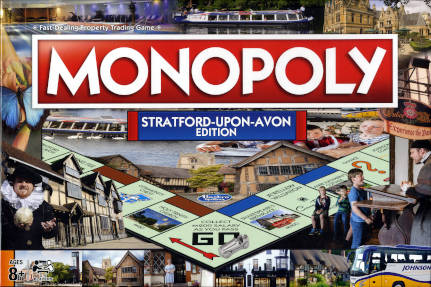
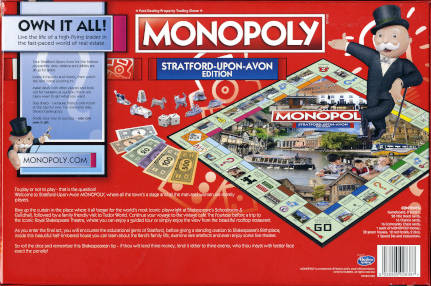
Available in Europe through Amazon and other dealers.
Horrorgami
A superb origami — also known as horrorgami — by Marc Hagan-Guirey, for his "Horrorgami exhibition" (Gallery One-And-A-Half, UK, 2012-2013).
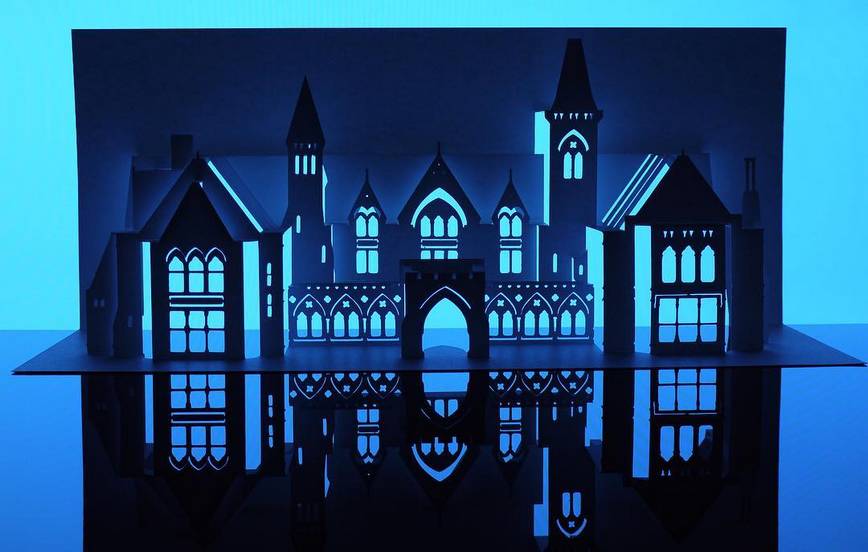
MGM studios
About Elstree and Borehamwood studios
Once known as the 'British Hollywood', Elstree and Borehamwood has played a significant role in the history of film making. It might be difficult to imagine glamorous stars like Grace Kelly, Errol Flynn, Ingrid Bergman, Elizabeth Taylor, Gregory Peck, Sophia Loren and Cary Grant in Borehamwood, but they have all worked at studios here along with British celebrities including Laurence Olivier, Anna Neagle, John Mills, Alec Guinness and Ralph Richardson.
Bringing this roll-call of honour more up to date, the blockbuster Star Wars trilogy was filmed in the town, as were Steven Spielberg's rip-roaring Indiana Jones adventures starring Harrison Ford. And the tradition continues. Today the area continues to be a focus for the entertainment industry with both Elstree Studios and the BBC's own regional broadcasting studios based at the centre of Borehamwood.
Recognising that the site was vital to the heart, identity and economy of the town, Hertsmere Borough Council, supported by local residents, embarked on a lengthy rescue campaign culminating in the acquisition of the Studios in February 1996.
After extensive refurbishment and renovation, the world famous Elstree Film Studios opened for business again in December 1996 with a star-studded gala celebration.
Four other studios operated in Borehamwood. Three had relatively short lives - British Dominion, Gate Studios and Danziger Brothers Studios. The fourth, the MGM British Studio, occupied a 120-acre site and operated until 1970 attracting stars of the calibre of Spencer Tracy, Elizabeth Taylor, Clarke Gable, Ava Gardner, Robert Taylor and Grace Kelly to Borehamwood.
Today the MGM site is a mixture of business and residential development with only the street names recalling its celluloid past. ~ from www.gearthhacks.com
On the map
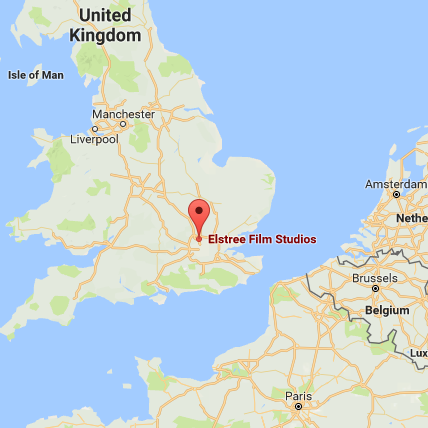
Elstree and Borehamwood studios
Shenley Road
Borehamwood
WD6 1JG
UK
Europe
Aerial picture from 1966
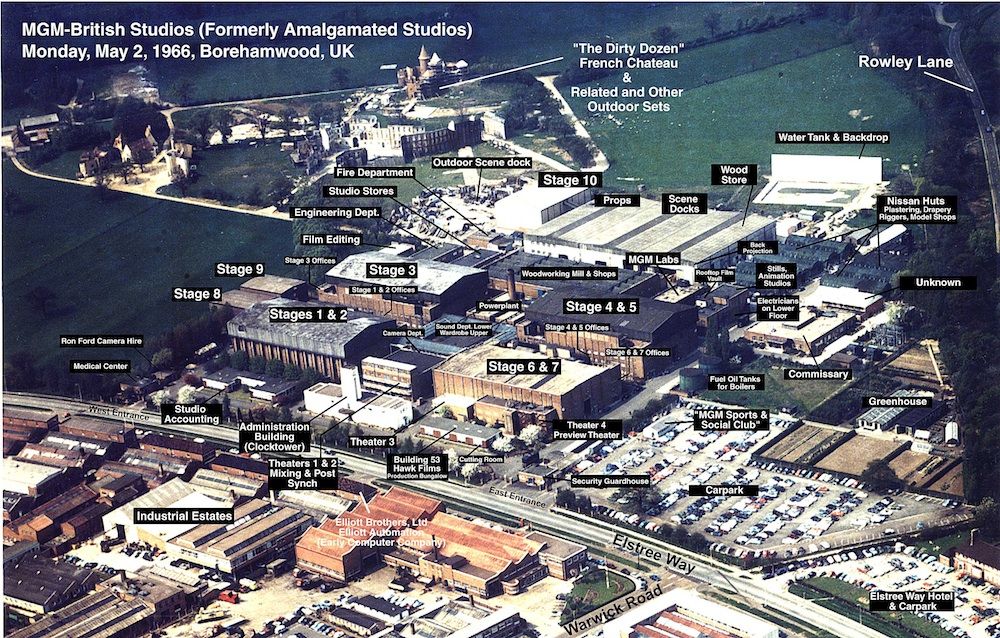
Elstree and Borehamwood studios, Shenley Road, Borehamwood, WD6 1JG, UK, Europe, also known as the MGM British studios
~ from www.thestudiotour.com
Studios history
In 1913, Percy Nash and John East reconnoitred London's green belt in search of a fog-free zone which had a good train service to London, beautiful scenery for location work, and most important of all an excellent site for a film studio. They discovered Elstree, or rather Borehamwood, an area adjoining the old village of Elstree. The two men purchased seven acres of Hertfordshire countryside and with Arthur Moss Laurence as the guiding force founded Neptune Films in 1914.
The new studios at Elstree were the finest in England at the time, purpose built, they resembled a row of alms-houses incorporating a projection theatre, dressing rooms with running water, administrative offices, generating plant and processing facilities. Between 1915 and 1920, Neptune leased or rented their studios to other companies. In 1925, American film entrepreneur J.D. Williams came, saw, and was conquered; he decided Elstree would become the British Hollywood. By 1925, J.D. Williams new studios were almost complete, and he had formed British National Pictures with W. Schlesinger and Herbert Wilcox. Discord soon arose between Williams and Schlesinger and the conflict developed into litigation, this allowed John Maxell to step in and gain control of both the company and studio. Having lost a considerable amount of money, Williams returned to the States and Wilcox left to form a new film company with Nelson Keys - The British and Dominion Film Corporation. Wilcox leased from Maxwell the studios that adjoined British International Pictures (B.I.P.) - the same studios he'd helped Williams build. Herbert Wilcox christened his new studios with his production of Madame Pompadour in 1927, but the first under the new B.I.P. banner was White Shark during the same year.
From the inception of B.I.P., John Maxwell had planned that it should be an international company, and set about surrounding himself with people he felt could understand this concept. Accordingly, in 1927 he acquired the services of a twenty-eight year old director called Alfred Hitchcock for a three-year, twelve-picture contract. Hitchcock's first picture for B.I.P. was The Ring, which received particularly excellent notices. Maxwell's next move was to appoint Walter Mycroft as head of studios, Mycroft became known as the 'Czar of the Rushes' due to his striking appearance and eye for detail. By 1928, Maxwell had acquired German company Sudfilm, with the aim of making and distributing films in Germany.
Walter Mycroft undoubtedly possessed the same eye for talent as John Maxwell, and in 1929 enrolled three men onto the B.I.P. payroll who were to become renown throughout the industry; Val Valentine, Sidney Gilliat and Frank Launder. By mid-1933 the Associated British Picture Corporation (A.B.P.C.) had been formed by Maxwell as the holding company to takeover the capital of B.I.P., B.I.F., Wardour Films, Pathe Pictures and his original A.B.C. circuit of 147 cinemas, but the studios were still to be known as B.I.P. until 1939. Catastrophe struck in 1936, on a chilly February morning fire swept through the British and Dominion studio belonging to Herbert Wilcox, leaving only smoking wreckage. Only valiant work by the local fire brigade prevented the fire from spreading to the B.I.P. studios literally yards away. Elstree was badly shaken by the loss of B&D studios. Maxwell was also twice outmanoeuvred when trying to expend his empire; firstly Maxwell believed he'd secured the take-over of Gaumont-British only for Twentieth Century Fox to strike a deal with Isidore Ostrer, and then in 1937 J. Arthur Rank secured Amalgamated Studios simply to prevent Maxwell acquiring them. War was declared on September 3rd, 1939 and John Maxwell was to die in 1940. An era had come to a close.
As World War II broke out, the Elstree studios were requisitioned and used in some form or another throughout the duration, primarily by the Royal Army Ordinance Corps. With peace in 1945, came a change of role for the studio, movie-making had changed; many of the old film hands and actors were not to return, many of the old studios had closed never to open again. John Maxwell had always hoped that his family would retain his film empire after his passing, but this was not to be. Warner Brothers acquired some family shares during the war and in 1946 they bought a vast bulk share from the Maxwell family, thus placing themselves in an unassailable position. Sir Walter Warter, Maxwell's son-in-law, became chairman and mastered a complete reconstruction of their Elstree studios. In 1947 the new A.B.P.C. studios were not yet completed, but the company decided to go ahead with its first post-war production: My Brother Jonathan.
In 1950, AB.P.C. decided to sell their Welwyn Studios and concentrate on Elstree. The following year the film doyens decided to create a special offering to mark the Festival of Britain, and The Magic Box, the story of inventor William Friese-Green, was to be produced in and around the AB.P.C. studios. It became clear to the board that independent television was to become a reality in Britain, and they decided to enter the stakes in 1955 when awarded the contracts for Midlands and Northern programmes on Saturdays and Sundays. Walter Mycroft died in 1959, but John Maxwell's other right-hand man, Robert Clark, was still firmly in charge of studio production. Although the threat of television must have been staring the studio squarely in the eye, the decade finished with some excellent productions like Ice Cold in Alex and Look Back in Anger.
The 1960's saw many imported American stars arrive at Elstree to star in productions, and the boom brought about more investment in studio facilities. New stages, cutting rooms, ancillary services, an underground car-park, restaurant, movie-history museum and office block were planned and commenced with a mid-sixties completion date in mind. Despite the heady boom at A.B.P.C. admissions to UK cinema in 1966 had dropped to a weekly average of 6 million, compared with 6.9 the previous year and 8.1 in 1964. In 1969, EMI purchased the remaining Warner's stake in A.B.P.C., and after a short fierce industry battle acquired a controlling interest in the company. The take-over saw Sir Philip Warter, Robert Clark and C.J. Latta go their separate ways, and EMI's chief executive Sir Joseph Lockwood announced a new board of directors. John Read was appointed chief executive of EMI, Bernard Delfont was appointed chairman of A.B.P.C, Bryan Forbes became the new head of production at Elstree. Forbes had been an actor, screenwriter of some distinction, and finally a director of some merit.
In 1970 it came as no surprise that there was to be a massive withdrawal of investment in the M.G.M.-British studios at Elstree, Borehamwood. It became clear that the studios were no longer economically viable and that closure was imminent. The news was softened by a statement from John Read chief executive of EMI, to the effect that although M.G.M. was to close its own studios, it would immediately form a partnership to take advantage of the EMI Elstree studios. The studios were to be renamed EMI-MGM Elstree Studios Ltd in return for a guaranteed annual subside from M.G.M.
In 1971, Elstree once again hit the headlines with the news that Bryan Forbes was to relinquish his responsibilities at EMI-M.G.M. Ian Scott, a director of A.B.P. in 1969, was appointed as the new managing director of the studios. By the end of 1972, in spite of the studio's successes, U.K. box-office takings had taken a nosedive with a vengeance and independent producers were beginning to feel the pinch. 1973 was no better and Elstree was beginning to lose money. An even bigger blow came with the news that M.G.M. in the States was withdrawing from film distribution, and would be withdrawing its annual subsidy to the EMI Elstree studio. Later that year Ian Scott left the studios to join Thames Television, and Andrew Mitchell was appointed managing director of the studios.
In 1976, EMI closed six of the nine stages and announced 213 redundancies leaving a skeleton staff of 48. What Andrew Mitchell had done was to streamline the studios, modernising the facilities which would allow independent producers to hire whom they wanted for any given period of time. The studio was now free from the massive overheads of its former days. The studio practically hummed for eighteen weeks when the biggest blockbuster the studio had ever witnessed, Star Wars, was shooting at Elstree.
In 1976, EMI decided on yet another acquisition, and bought independent company British Lion Films, and some months later installed former British Lion chiefs Barry Spikings and Michael Deeley as joint-managers of the newly titled EMI Films Ltd. While EMI was to emerge its distribution arm with Columbia-Warner in 1978, the studios were to have further good production news. Stanley Kubrick's The Shining was to take to the floor, and George Lucas' Star Wars follow-up, The Empire Strikes Back, was to commence the following year. In 1979, Elstree was to have another change within, Thorn amalgamated with EMI and thus the studios became Thorn-EMI. Peter Laister took overall control for the company's entertainment group.
However the 1980's brought a downturn in production again and the studio fell into disrepair. In 1988 Cannon sold the studios to the Brent Walker group, who continued film production for a short while under the Goldcrest name until that company collapsed. Planning permission was granted for part of the land to be developed for purposes other than filmmaking - and so today half of the site has been developed as a supermarket. However a proviso was laid down that the remaining site must be used for film production for a further 25 years.
After a lengthy legal battle and prolonged period of closure, Brent Walker eventually agreed to sell the studios back by Hertsmere Borough Council in February 1996. Now called the Elstree Film & Television Studios, further state of the art sound stages were completed in 1999 and were opened by HRH The Prince of Wales. ~ from britmovie.co.uk
Studios facilities
A very comprehensive technical descriptions of the studio was published in a Kine Weekly magazine in December 1962, so, very contemporary with the actual filming of the movie.
'Kine Weekly' (UK), Dec. 13, 1962 - Vol. 547, No. 2880
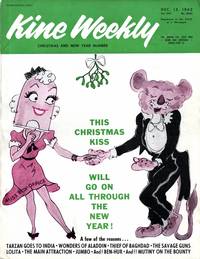

Issue: Dec. 13, 1962 - Vol. 547, No. 2880
Language: English
Country: UK
Content: One page (p109, black & white) fully describes the technical capabilities of the British MGM studio.
Page 109, article by Maurice Foster
This has been the busiest production year in our history as one of the world's major studios. Nevertheless, we were able to carry out the following developments and additions:
Two new stages (75ft. x 50ft.).
New large stage (100ft. x 120ft.) now being erected.
An outdoor tank (100ft. x 150ft.).
New office block.
Additional dressing rooms.
Additional cutting rooms.
An extension to our laboratory, providing full colour facilities in addition to the existing black and white facilities.
Alterations to our recording theatres enabling simultaneous dubbing in both theatres.
A new sound transfer suite.
A fifth viewing theatre.
A production and budgeting department.
A revolutionary accounting system, using electronic equipment which will produce up-to-date figures in a shorter time than has ever been considered possible.
A film library service.
Large standing sets on the lot.
Development of several new special effects processes including an amazing new matte technique.
A new sound facility, developed by MGM in Hollywood which enables far greater use of location sound than has been possible up till now.
A fleet of various cars and for other general purposes at considerably lower rates than available from outside.
Extension of car parks.
Re-laying of all studio roads.
Redecoration of the restaurant and canteen and the inclusion of a bar.
The modernisation of production and producers' offices.
The building of many new stock sets, including a complete Boeing 707 and cockpit.
In addition, we have already started our next series of developments of which the following are almost complete:
Extension of stills studio (the largest in England) which can now also be used, when available, as an insert or small stage.
Enlargement of property department to cope with our increasing stock of props.
Additional film vaults.
Re-laying of all stage floors.
A large concrete area on the lot to facilitate the building of further exterior sets.
A department to promote commercial tie-ups with production.
We are constantly examining new techniques and processes for the benefit of production as illustrated by many of our developments. In this respect we also have the advantage of being advised by MGM's studios in Culver City (which are the largest in the world) of all new American developments, often when these are only in the planning stage.
We can only look backwards for 15 years, since it was not until 1947 that the first film was made by these studios. This was "Edward My Son," directed by George Cukor, and starring Spencer Tracy and Deborah Kerr. Since then a continuous stream of the top producing, directing and acting talent has worked here resulting in some of the most important productions that have been made in Britain.
The outcome of these experiences is the most comprehensive production service ever known and this exists for both our own films and independent productions. Furthermore, it has created economies in operation which not only provide a producer with more facilities at lower cost but enable him to work with more efficiency.
Our declared policy is a simple one — we offer our help and experience to producers for the purpose of making films. We are proud to be known as "the studio that is your production organisation" and we look forward to the future with the conviction that no producer using our studios will from choice make his films elsewhere — for where else could he make them more cheaply, more efficiently and more successfully?
Facilities
- Name: METRO-GOLDWYN-MAYER BRITISH STUDIOS
- Location: Elstree Way, Boreham Wood, Herts
- Studio owner: Metro-Goldwyn-Mayer British Studios Ltd.
- Number of stages: Nine.
- Dimensions of stages:
- 74 ft. x 96 ft.
- 120 ft. x 96 ft.
- 194 ft. x 96 ft.
- 120 ft. x 96 ft.
- 74 ft. x 96 ft.
- 118 ft. x 98 ft.
- 72 ft. x 89 ft.
- 75 ft. x 50 ft.
- 75 ft. x 50 ft.
- Dimensions of lot: 114 acres.
- Special facilities:
- Exterior Tank — 150 x 100 x 2 ft. 6ins. (containing section 25 ft. x 50 ft. x 11 ft. deep);
- Tank — Stage 1 — 15 x 5 x 4 ft. deep;
- Tank — Stage 2 — 21 x 9 x 8 ft. deep;
- Tank — Stage 3 — 81 x 31 x 11 ft. deep;
- Two Tanks — Stage 6 — 37 x 20 x 11 ft. deep and 16 x 9 x 7½ ft. deep;
- Beam-splitting camera;
- Back projection;
- Travelling Matte;
- Auto-motion;
- Mechanical horses.
- Dubbing theatres: Two (background suppression equipment, Mackenzie repeaters, Fairchild attenuators, graphic equalisers).
- Preview theatres: Five (reverse running projection and remote control focus in two theatres).
- Editing facilities: 16-mm., 35-mm., 65-mm., 70-mm., Colour, Black and White.
- Sound channels available: Eight floor recording channels.
- Power available: 50,000A 1,000 horse-power standby diesel plant.
- Equipment available on hire: Playback equipment for film and disc; lanyard microphones, Syncropulse tape recorder with four channel mixer.

